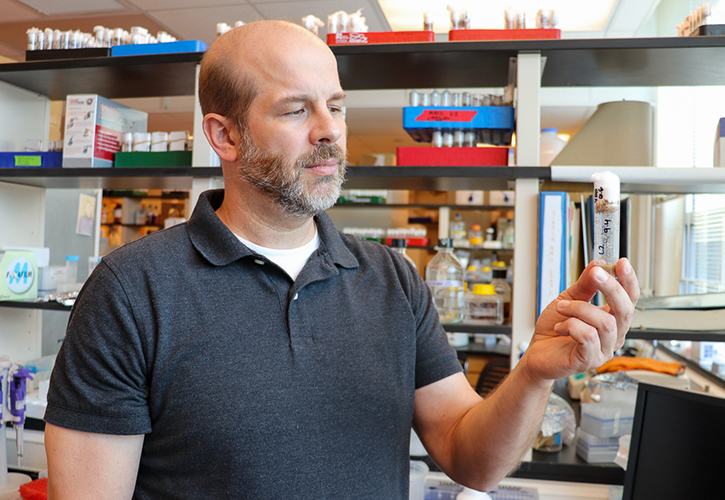College of Arts and Sciences Newsroom

National Science Foundation awards $1M to UD biologist to study how traits evolve
By Dave Larsen
The National Science Foundation awarded University of Dayton biologist Thomas Williams more than $1 million to study how physical traits develop and evolve at the DNA level, and then test his findings through genetic engineering.
The four-year, $1,036,507 grant that started Sept. 1 also will enable Williams to sustain a research lab staff of one doctoral, two master’s and eight undergraduate students, allowing him to resume training future scientists at his pre-pandemic level. Williams shares the award with research collaborator Mark Rebeiz, professor in the University of Pittsburgh Department of Biological Sciences.
The grant is Williams’ third and largest from the NSF in the last 10 years, following awards of $839,000 in 2016 to and $450,000 in 2012. Under his previous funding, he developed an investigative model using color patterns on the abdomens of fruit flies to study the ways in which DNA sequences function to switch genes “on” and “off” during an organism’s development. He then studied how evolution used these so-called “genetic switches” to develop biological diversity.
“By answering questions, we’ve created lots of new questions within this same model,” said Williams, associate professor of biology. “So, we are trying to understand for an organism that has around 13,000 genes, which are the 100 or 200 that are responsible for making one characteristic, and how is it that these genes know in which cells and when during life to be active.”
Williams will study DNA in the model fruit fly species Drosophila melanogaster to find and characterize the parts of genes responsible for variations in the abdomen color patterns of male fruit flies. He also will look at DNA in two less well-studied fruit fly species that look different but have the same genes. His goal is to understand how a genetic program changed to make them appear different.
“Everything we’re asking here about fruit flies are the same things that have to be spelled out in the language of our own DNA to make sure things are produced in the right place at the right times during development,” Williams said. “When changes happen in the DNA sequence and it goes wrong, we get things like genetic diseases or a variation from one individual to another.”
Williams is an evolutionary developmental — or “evo-devo” — biologist. His research is rooted on 1980s discoveries that found radically different organisms have similar sets of genes, suggesting much of the Earth’s biological diversity comes not from new genes, but how the same genes are used differently.
Roughly 60% of the fruit fly’s genes can be found in humans in similar form, and about 75% of the genes responsible for human diseases have counterparts in flies.
“The lessons we learn about the genes in fruit flies give us insights about how these genes might be functioning in our bodies as well,” he said.
Advances in genetic research since Williams’ 2016 NSF grant now make it possible to edit animal genomes, allowing him to remove and replace DNA sequences from fruit flies to study how those genes impact their appearance over time. Because the fruit fly can birth a new generation in only 10 to 15 days, Williams can follow evolutionary changes through as many as 24 generations per year.He said taking DNA sequences from Drosophila melanogaster and editing them into the other emerging model species is considered a safe procedure.
“Nobody has to worry that we’re making some sort of genetically engineered monsters,” Williams said. “The stuff that we’re playing with, at best it’s going to affect a little bit of melanin on the abdomen of fruit flies.”
Karolyn Hansen, associate professor and Department of Biology chair, likened Williams’ approach to having a drawer with a variety of hand tools that, when used in varying combinations, result in objects with different colors and patterns.
“That's what is really cool about Dr. Williams' genetics research: he is not just identifying what happens, rather he is investigating how different 'tools' determine gene expression, and his science will inform the wider gene expression research community,” Hansen said.
The NSF grant will allow Williams to support several graduate students, as well as two undergraduates from each academic year — freshman, sophomore, junior and senior — to work in his research lab. He also plans to mentor a number of undergraduates in genetic experimentation outside of the traditional school year through the College of Arts and Sciences Dean’s Summer Fellowship program.
In addition, he expects Dayton-area high school science teachers and community college students to visit his lab through the UD Sinclair Academy and a partnership with the Louis Stokes Alliances for Minority Participation, a NSF-funded program intended to support historically underrepresented students in the STEM fields.
“In addition to pursuing groundbreaking science, Dr. Williams focuses on sharing his science, passion and inquisitiveness with the many students who are trained in his laboratory,” Hansen said. “His training continuum includes undergraduate researchers, honors thesis students, and master’s and doctoral students. His students have gone on to medical school, graduate school, and successful careers in academia and industry.”
For more information, visit the Department of Biology website.
